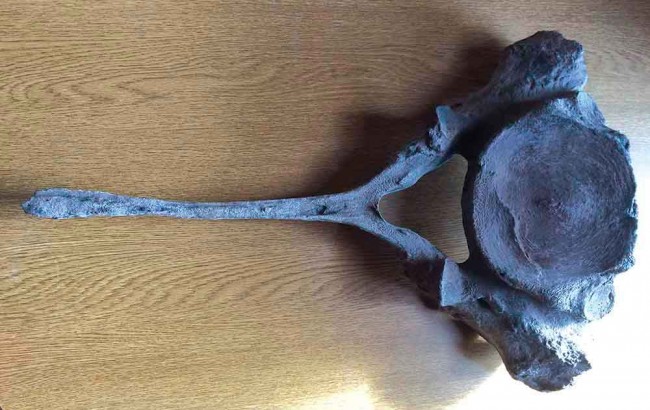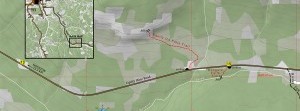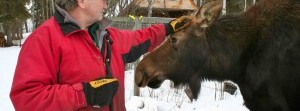
A Mammoth Discovery: Decades later, fossils still shrouded in mystery
In the summer of 1971, men and machines were working on removing the overburden (mining lingo for “dirt”) on Noranda’s Bell Mine on the Newman Peninsula of Babine Lake when their work revealed a jumble of ancient, oversized bones.
Labourers stopped machines and spoke to one other. They examined the bones, discovered large tusks and surmised they must have belonged to an enormous, ancient elephant. The workers called their supervisors, who called the managers, who came together and considered their situation.
What happened next is up for debate. Some say work was halted and the area was immediately roped off for preservation while experts were notified. Some say an order was given to excavate the bones and bury them elsewhere so work could progress on schedule.
The prohibitive costs of a lengthy paleontological excavation may have led to decisions that were not in the interest of science. There was talk that the bones were so many, they must have belonged to more than one ancient beast. Some say that outside agencies were only notified when all but one of the remains had been removed, destroyed and buried elsewhere. Even impartial scientific reports and National Research Council publications mention that souvenir hunters compromised the discovery site by removing some of the earliest exposed material.
What is known for sure is one of Canada’s best and brightest geologist, Howard Tipper, happened to be in Smithers mapping the region for the Geological Survey of Canada. Tipper and a team of students were sent to the discovery site north of Granisle to lead the excavation of what would become known as the Babine Lake mammoth.
Racing the time clock
The Bell Mine manager and labourers aided Tipper and his team. Normal stripping operations were stopped for two days while they documented and excavated the bones from a 100-square-foot area.
“Work was hampered by heavy rain and had to be rushed so that stripping could continue,” a 1973 scientific report states. “A bulldozer and a backhoe were used to speed up the work.”
Tipper would later recall that he’d never in his life seen a bulldozer operated so gently.
“It was most unscientific but we were racing against time,” he said. In spite of poor weather, shortness of time and the churning of sediments by heavy equipment, Tipper managed to pack 12 large crates with tusks, vertebrae, leg bones, ribs and key geological samples and sent them to the National Museum of Natural Sciences, now the Canadian Museum of Nature, in Ottawa.
On July 14, 1971, the Smithers’ Interior News reported that, “The 20,000-year-old remains of an ice-age elephant found in the Babine Lake area began arriving at the National Museum of Science in Ottawa on Wednesday, July 7. Initial assessment indicates that the beast was a mastodon.”
At the museum, Richard Harington received the bones and studied them thoroughly. The Order of Canada recipient and ice-age vertebrate expert concluded that, “The Babine Lake mammoth would have had an estimated height at the shoulder of 10 feet, 10 inches or perhaps 11 feet, four inches in the flesh.”
The bones Tipper collected and sent east showed Harington that the Babine Lake mammoth was a hairy-coated Mammuthus columbi, a very large mammoth—much larger than the American mastodon. It had tusks that curved gently downward, outward, then inward.
The dark organic silt that Tipper collected from the pit was analyzed for pollen content and showed an ancient environment of birch, grasses and willow. Soil showed the Babine Lake mammoth lived in a cool grassland habitat with some shrubs and scattered trees.
Harington and other experts studied the bones, the descriptions made on site and photos from the excavation, and worked with Tipper to determine that the mammoth died at the site 34,000 to 43,000 years ago. Another report, from 1974, states, “Radiocarbon analysis of bone collagen from an anterior rib fragment of the Babine Lake mammoth gave the date of 34,000 (± 690) years before present.”
Harington concluded the Babine Lake mammoth was trapped in the black mud of a bog and evidently sank deeper as it struggled. The scientists could find no evidence it was killed by humans. Around the time it died, Tipper explained in the Canadian Journal of Earth Sciences, ice was retreating along the valleys of Babine Lake and the Bulkley River. These scientific conclusions were based on a partial skeleton, excavated in adverse conditions by an ad hoc team of nearby professionals.
Both Tipper and Harington noted the site was suspiciously lacking all the teeth, which usually are preserved the best. Scientific reports published by Tipper and Harington all allude to or state directly that the site was compromised and mammoth bones were removed from the discovery location before Tipper’s arrival.
The mystery deepens
In 2002, the wife of a machine operator who worked at Bell Mine in 1971 made a donation to the Bulkley Valley Museum in Smithers. She said the bones were smuggled off-site by a worker at the time of the Babine Lake mammoth discovery. Museum staff sent photos to Harington, who was still working in Ottawa. He confirmed that they were bone fragments from the Babine Lake mammoth.
The donor confirmed speculation that teeth and other bone fragments were removed from the site shortly after discovery and alluded that others in the area may still have the mammoth remains.
Tipper, who was also contacted, stated in a 2002 Interior News article, “There were pieces (of mammoth remains) found in the dump area that didn’t come from the site we excavated. Some of the bones found weren’t the right size (for the mammoth they were digging up).”
A former mine employee told the Interior News, “There were a great number of bones and tusks taken out by the workers, it would be great if they could be recovered.”
The machine operator’s wife said workers hauled millions of yards of coal-embossed bog with mammoth bones and bulldozed them into a nearby overburden dump. For 1971, this compromise of an ancient paleontological site was not unusual. Tipper and Harington both credited the mining company and the machine operators with taking remarkable steps for science, considering the era, by allowing them to excavate. Every minute the workers weren’t working meant thousands of lost dollars for the company.
While the bones excavated in 1971 remain at the Canadian Museum of Nature in Ottawa, those donated to the Bulkley Valley Museum are in its secure storage. Replica casts of the leg bones and a vertebra of the Babine Lake Mammoth are visible at Granisle’s Visitor Centre and Museum.
Harington has stated that, “The Babine Lake mammoth is significant because it is one of the most complete ones found in BC.” He encouraged others to come forward because, “Even if fragmentary teeth can be found, or other bones in the skeleton, it would help to precisely identify this magnificent skeleton.”
In a 2002 Interior News article, Harington implored anyone who may have additional Babine Lake mammoth bones to donate them to a museum where they could add to the specimen’s scientific value and contribute to understanding the ancient Granisle area. Any mammoth teeth, tusks or bone fragments sitting in a basement gathering dust can be donated: there will be no fines, museum staff would contact experts and science will thank you.
If scientists could glean the age, size, diet and cause of death from a partial skeleton in 1971, imagine what additional mammoth bones could reveal today.






